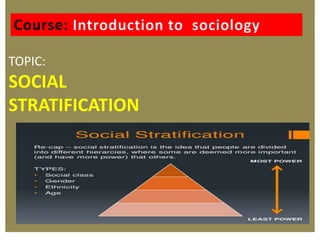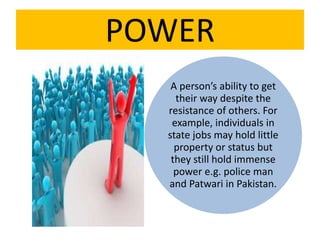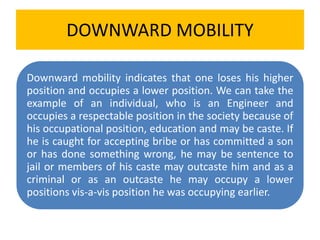Lecture 7 Social Inequality, Social Stratification
- 2. SOCIAL STRATIFICATION ? social stratification is a trait of society, not simply a reflection of individual differences. ? social stratification carries over from generation to generation ? social stratification is universal but variable ? Social stratification involves not just inequality but beliefs as well A system by which a society ranks categories of people in a hierarchy is based on four important principles.
- 3. Social stratification refers to ¡°the ranking of individuals on a scale of superiority- inferiority-equality, according to some commonly accepted basis of valuation¡±(Williams) Classification of persons into groups based on shared socio-economic conditions, a relational set of inequalities with economic, social, political and ideological dimensions. SOCIAL STRATIFICATION
- 4. CAUSES OF SOCIAL STRATIFICATION Inequality Conflict Power Wealth Instability
- 5. DETERMINANTS OF SOCIAL STRATIFICATION SLAVERY CASTE CLASS STATUS POWER EDUCATION ECONOMIC RRESOURCES OCCUPATION PRESTIGE
- 6. Slavery Slavery is the earliest form of social stratification. It is the legally recognized division of society into slaves and citizens. Citizens have the citizenship rights whereas the slaves does not have citizenship rights. It existed in most of the parts of Europe and other ancient nations between 500 BC to 600 BC.
- 7. CASTE Caste can be defined as a hereditary intermarrying group which determines the individual¡¯s status in the social stratification by his occupation, etc. caste system in Pakistan is an important element in social stratification. Some castes are considered high, some are low e.g. Syed Rajput have the highest place in social stratification of castes as compare to Kameen in Pakistan. Same condition is prevailing in India.
- 8. TRADITIONAL CASTES OF INDIA BRAHMANS KSHATRIYAS VAISYAS SHUDRAS HARIJANS
- 9. CLASS Social stratification is also based on class. Class is a status group and in only society the social status of one group always differs from that of another. Class is also a person¡¯s economic position in a society. however, as per Weber, class is not a supreme factor in stratification. He noted that how Managers of corporations or industries control firms they do not own. In a class system, social stratification is based on individual achievement.
- 10. STATUS Status is the person¡¯s prestige, social honor, or popularity in a society. social stratification is also based on status of person. Weber noted that political power was not rooted in capital value society, but also in one¡¯s individual status. Poets or saints can possess immense influence on society with often little economic growth.
- 11. POWER A person¡¯s ability to get their way despite the resistance of others. For example, individuals in state jobs may hold little property or status but they still hold immense power e.g. police man and Patwari in Pakistan.
- 12. EDUCATION Education like all other societies in the world, defines social status in Pakistan too. Educated people are better rated and respected socially owing to their occupations, professions and status while illiterate people always belong to lower class. For example, Dr.Abdul Qadeer Khan has a great respect in Pakistan for his education and great contribution in making Pakistan a Nuclear Power.
- 13. ECONOMIC RESOURCES The level of income from all Economic Resources is an important indicator of ones place in society. the size of landholding in rural areas is an important measure. Those who tenets and those who belong to serving class like carpenter, blacksmith, cobbler, barber, washer man and other can be placed in lower class. In urban areas the big industrialists, whole sale and big businessmen, high class officials belonging to government and other agencies, high class technicians and other professions like advocates, medical practitioners and other belongs to upper class.
- 14. OCCUPATION Occupation is also an important indicator of stratification in every society. In Pakistani society the high class professionals are owners landlords, owner cultivators, industrialists, big wholesale businessmen and high class government and semi government officials. In lower class all manual workers like cobblers, carpenters, blacksmith, washer man, peon, sweeper and unskilled labor etc.
- 15. PRESTIGE If individual has high prestige in social life, he is regarded most respectful person. The social prestige in a community in our society depends upon the Nobility of the individuals Participatin g generally in welfare works He is true to his words
- 16. ORIGINS OF SOCIAL STRTIFICATION HUNTING AND Gathering societies Horticultural, Pastoral, and Agricultural societies Division of labor and job specialization Industrialized societies The improvement of working conditions
- 17. SOCIAL MOBILITY Moving from one social class to anther is called mobility. The ability of individual or groups to move upward or downward in status based on wealth, occupation, education or some other social variable (Horton and Hunt).
- 18. TYPES OF MOBILITY HORIZONTAL VERTICAL UPWARD MOBILITY DOWNWARD MOBILITY INTER- GENERATION MOBILITY
- 19. HORIZONTAL MOBILITY Under this type of social mobility, a person changes his or her occupation but the overall social standing remains the same. Certain occupations like Doctor, Engineers and professor may enjoy the some status but when an engineer changes his occupation from engineer to teaching engineering, he has horizontally moved from one occupational category to another.
- 20. VERTICAL MOBILITY Vertical mobility refers to any change in the occupational, economic or political status of an individual or a group which leads to change of their position. The relations involved in transition of individual or a social object from one social stratum to another. It may be upward mobility or downward mobility.
- 21. UPWARD MOBILITY When a person or a group of persons move from lower position to upper position it is called upward mobility e.g. Lower caste person After Getting Education Achieve a good position is a good example of upward mobility.
- 22. DOWNWARD MOBILITY Downward mobility indicates that one loses his higher position and occupies a lower position. We can take the example of an individual, who is an Engineer and occupies a respectable position in the society because of his occupational position, education and may be caste. If he is caught for accepting bribe or has committed a son or has done something wrong, he may be sentence to jail or members of his caste may outcaste him and as a criminal or as an outcaste he may occupy a lower positions vis-a-vis position he was occupying earlier.
- 23. INTER-GENERATIONAL MOBILITY This type of mobility means that one generation changes its social status in contrast to preceding generation. However, this mobility may be upward or downward e.g. people of lower caste or class may provide facilities to their children to get higher education, training and skills.























